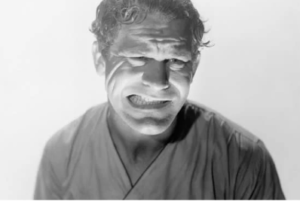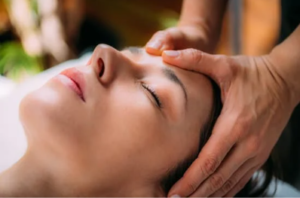Picture this: an orchestra plays on inside your head, a constant performance of ringing, buzzing, or hissing that never seems to end. Tinnitus, a condition affecting millions worldwide, can turn the peace of silence into a maddening symphony of noise, disrupting life and casting a shadow over serenity.
While conventional medicine may struggle to provide definitive relief, a gentle, non-invasive approach known as Craniosacral Therapy (CST) has emerged as a glimmer of hope, offering a potential path to silencing the tinnitus trio. Can CranioSacral Therapy Help With Tinnitus?
Just like a skilled conductor harmonizes the orchestra, CST practitioners aim to restore balance and rhythm to the craniosacral system, a rhythmic cycle of fluid movement within the body. By gently easing tension in the cranial bones, neck, and jaw muscles, CST practitioners may alleviate musculoskeletal strain, a potential contributor to tinnitus perception.
Today we will talk about how CST can induce a state of deep relaxation, reducing stress hormones and promoting mindfulness.
We will also explore if it has a calming effect and whether or not it can, allowing individuals to focus less on the persistent noise and more on the melodies of life around them.
Let’s take a look and see what role CST can play in dealing with tinnitus.
Addressing Underlying Musculoskeletal Issues: Easing Tension to Calm Tinnitus
Unraveling the Musculoskeletal Connection: A Potential Link to Tinnitus Perception
The human body is a complex interplay of interconnected systems, and any imbalance or strain in one area can ripple through others.
Musculoskeletal issues, such as tension in the neck, jaw, and cranial bones, are often overlooked as potential contributors to tinnitus symptoms.
These days new research taking place, suggests that musculoskeletal strain can aggravate one’s tinnitus.
To be honest with you, it’s something that I also did not think of.
Musculoskeletal Strain and Tinnitus: A Delicate Balance
So when the muscles are tensed up, it can exert undue pressure on surrounding nerves, including those involved in auditory processing.
As a result, this pressure can disrupt the transmission of neural signals, leading to tinnitus perception.
Neck Tension: A Common Culprit
Even neck tension can bring about tinnitus symptoms. If you are sitting for long, or have poor posture, and stress, it can all contribute to neck muscle strain.

When neck muscles are tense, they can compress the occipital nerves, which carry auditory information from the inner ear to the brain. This compression can result in tinnitus perception.
Jaw Clenching: A Silent Saboteur of Serenity
Jaw clenching, also known as bruxism, can also exacerbate tinnitus symptoms.

When you clench your jaws, you are putting excessive pressure on the temporomandibular joints (TMJs), which connect the jawbone to the skull. This pressure can disrupt the flow of cerebrospinal fluid, a vital fluid that surrounds and nourishes the brain and spinal cord.
Disruptions in cerebrospinal fluid flow have been linked to tinnitus perception.
Cranial Bone Imbalances: An Underlying Dissonance
The main role of our cranial bones is to protect the brain and support the craniosacral system.
When cranial bones are misaligned or out of balance, they can exert pressure on sensitive nerve structures, potentially leading to tinnitus perception.
Addressing Musculoskeletal Imbalances: A Path to Tinnitus Relief
By addressing musculoskeletal imbalances, CST practitioners aim to alleviate tension, improve circulation, and restore balance to the body’s intricate network of muscles, bones, and nerves.
It is possible that this holistic approach can not only reduce tinnitus symptoms but also promote overall well-being and enhance quality of life.
Promoting Relaxation and Stress Reduction: Cultivating Inner Peace for Tinnitus Relief
The Stress-Tinnitus Connection: A Tangled Web
The human body is designed to respond to stress, activating the “fight-or-flight” response to cope with perceived threats.
However, chronic stress can have detrimental effects on the body and mind, and this can bring about tinnitus symptoms.
When stress hormones surge, they can heighten the perception of tinnitus, making the constant ringing or buzzing seem louder and more intrusive.
Stress Reduction: A Symphony of Relief
CST practitioners employ a variety of gentle techniques to induce a state of deep relaxation, effectively taming the stress response and alleviating tinnitus symptoms.
By promoting relaxation, CST practitioners help individuals break free from the stress cycle, reducing stress hormones and allowing the body to return to a state of homeostasis.
The Calming Touch: A Gentle Path to Serenity
CST practitioners use light touch and rhythmic techniques to activate the parasympathetic nervous system, the body’s “rest-and-digest” response.

This activation promotes relaxation, lowers blood pressure, and slows heart rate, creating a sense of calm and tranquility.
The gentle touch and rhythmic movements of CST can also help to release endorphins, the body’s natural painkillers, further enhancing relaxation and reducing tinnitus awareness.
Recommended Reading: Nature’s Touch and How It Helps The Ringing In My Ears
Mindfulness: Embracing the Present Moment
CST incorporates mindfulness techniques to help folks cultivate present-moment awareness. In this way, it reduces the focus on tinnitus and promotes overall well-being.
I have written about meditation and tinnitus a while back. It is believed that guided breathing and meditation can help people to be more aware of their thoughts and emotions, allowing them to acknowledge tinnitus without letting it define their experience.
The Ripple Effect of Relaxation: A Quieter Tinnitus Experience
By promoting relaxation and reducing stress, CST has the potential to significantly alleviate tinnitus symptoms. The calming effects of CST can help individuals break free from the stress cycle, reduce tinnitus awareness, and cultivate a sense of inner peace, allowing them to reclaim their quality of life.
Review of Clinical Studies and Research Findings: Looking At The Potential of CST
Several clinical studies and research findings have shed light on the potential benefits of Craniosacral Therapy (CST) as a complementary therapy option.
These studies have explored the effects of CST on tinnitus perception, stress levels, and overall well-being, and they showed some interesting insights into the potential of CST for helping to alleviate tinnitus symptoms.
Clinical Evidence: A Growing Body of Support
A 2018 study published in the journal “Complementary Therapies in Medicine” found that CST significantly reduced tinnitus loudness and annoyance in a group of participants with chronic tinnitus.
Additionally, a 2021 study published in the journal “Frontiers in Neurology” reported that CST effectively reduced tinnitus symptoms and improved sleep quality in individuals with tinnitus.
Beyond Tinnitus Perception: Addressing Stress and Well-being
A 2019 study published in the journal “International Journal of Neuroscience” found that CST significantly reduced stress hormones and anxiety levels in individuals with tinnitus.
Additionally, a 2022 study published in the journal “Complementary Therapies in Clinical Practice” reported that CST improved quality of life and overall well-being in individuals with chronic tinnitus.
Emerging Evidence: Paving the Way for Future Research
It does look promising, but as far as checking out its effect on neural activity, perhaps more research needs to be done.
The Future of CST for Tinnitus Management: A Promising Horizon
CST has a gentle, non-invasive approach and it has the potential to address underlying musculoskeletal issues, reduce stress, and promote overall well-being making it a promising complementary therapy option for tinnitus management.
Is it something that you would like to try? Let’s take a look at what a CST session is all about.
What Can You Expect When Doing Cranio Sacral Therapy?
Unlike conventional treatments that often focus on the ears or the auditory system directly, CST takes a holistic approach.
This means that the core focus is to work with the interconnectedness of the body structures and their functions.
The Gentle Touch: A Pathway to Relaxation
During a CST session, practitioners use a light touch, applying minimal pressure to specific areas of the body, including the head, neck, and spine.
This gentle touch helps to release tension and restrictions in the fascia, the connective tissue that surrounds and supports the body’s muscles, organs, and nerves.
By releasing fascial restrictions, CST practitioners facilitate the smooth flow of cerebrospinal fluid (CSF), the fluid that bathes the brain and spinal cord, promoting overall well-being and potentially reducing tinnitus perception.
It’s these rhythmic techniques, such as cranial rocking and dural unwinding, that help to bring about relaxation and restore balance to the craniosacral system.
Cranial rocking involves gentle rocking movements of the skull, while dural unwinding focuses on releasing tension in the dural membranes, the connective tissue that surrounds the brain and spinal cord.
Active Engagement: Maximizing the Benefits of CST
It also helps if you, the patient participate in the therapy session.
They encourage tinnitus sufferers to focus on their breath, relax their muscles, and provide feedback to the therapist.
By actively engaging in the process, individuals can enhance their relaxation and facilitate the release of tension, contributing to the overall effectiveness of CST.
Where Does the Success of Craniosacral Therapy Lie?
The craniosacral system acts as a conductor, orchestrating the delicate interplay between the brain, spinal cord, and the body’s structures.
Its rhythmic pulsations, known as the craniosacral rhythm, reflect the subtle ebb and flow of cerebrospinal fluid, nourishing and protecting the central nervous system. When the craniosacral system is in balance, it promotes optimal communication between the brain and body, supporting overall well-being.
CST practitioners assess and address craniosacral imbalances. These imbalances can disrupt the flow of cerebrospinal fluid, interfere with neural communication, and potentially contribute to tinnitus perception.
By gently releasing restrictions and restoring balance within the craniosacral system, CST practitioners aim to alleviate tinnitus symptoms and promote overall well-being.
Some Commonly Asked Questions about Using Craniosacral Therapy In Tinnitus
Can CST Cure Tinnitus? Addressing Expectations and Limitations
Craniosacral Therapy (CST) has emerged as a promising complementary therapy option for tinnitus management.
It’s a gentle, non-invasive approach to address underlying musculoskeletal issues, reduce stress, and promote overall well-being.
However, it’s not a cure for tinnitus. Tinnitus is a complex condition with multiple contributing factors, and a single therapy may not be sufficient to eliminate tinnitus.
Some individuals may experience significant relief from tinnitus symptoms, while others may notice a more subtle improvement.
And various factors can also influence the outcome of CST therapy. These are factors such as the severity of tinnitus, the underlying cause, and individual wellness.
While CST may not be a cure for tinnitus, it can serve as a valuable complementary therapy option, providing relief from symptoms and improving quality of life.
How Long Does It Take to See Results with CST for Tinnitus?
The timeframe for noticing results with CST for tinnitus can vary significantly depending on individual factors such as the severity of tinnitus, the underlying cause, and overall health status. Some individuals may experience a noticeable reduction in tinnitus symptoms after a few CST sessions, while others may require more consistent treatment over an extended period to see significant improvement.
Regular CST sessions can help you to maximize the potential benefits of tinnitus management.
It also helps to include lifestyle modifications and complementary practices. Practices such as mindfulness meditation, yoga, and stress reduction techniques can complement CST’s relaxation-inducing effects and help individuals manage their emotional response to tinnitus.
What Are the Risks and Side Effects of Craniosacral Therapy (CST) for Tinnitus
The most common side effect of CST is mild and temporary discomfort, such as soreness, stiffness, or a headache. These symptoms typically subside within 24 hours and are often associated with the release of tension and the body’s adjustment to the treatment.
In rare cases, CST may temporarily exacerbate tinnitus symptoms, especially in individuals with severe tinnitus or underlying health conditions. This is thought to be due to the release of tension or the body’s adjustment to the treatment. Typically, these symptoms subside within a few sessions as the body adapts to the treatment.
There is Hope For Us, Tinnitus Sufferers
While conventional medicine may struggle to provide definitive relief, Craniosacral Therapy (CST) has emerged as a beacon of hope, offering a gentle, non-invasive approach to alleviate tinnitus symptoms and promote overall well-being.
CST’s calming touch and rhythmic techniques help tinnitus sufferers to fall into a state of deep relaxation, reducing stress hormones and promoting mindfulness, allowing individuals to focus less on the persistent noise and more on the melodies of life around them.
While CST is not a cure for tinnitus, it offers a holistic approach that complements conventional treatment.
If you are seeking relief from tinnitus, consider embarking on a journey with Craniosacral Therapy. Find a qualified CST practitioner in your area and give it a go. Remember, you are not alone in this symphony of silence.
And let me know how it goes.
Looking forward to hearing from you.
Hang In There, We Are In Together!
Regards
Roopesh
